2023年英语中考语法专项总结一 名词课件(共42张PPT)
文档属性
| 名称 | 2023年英语中考语法专项总结一 名词课件(共42张PPT) |
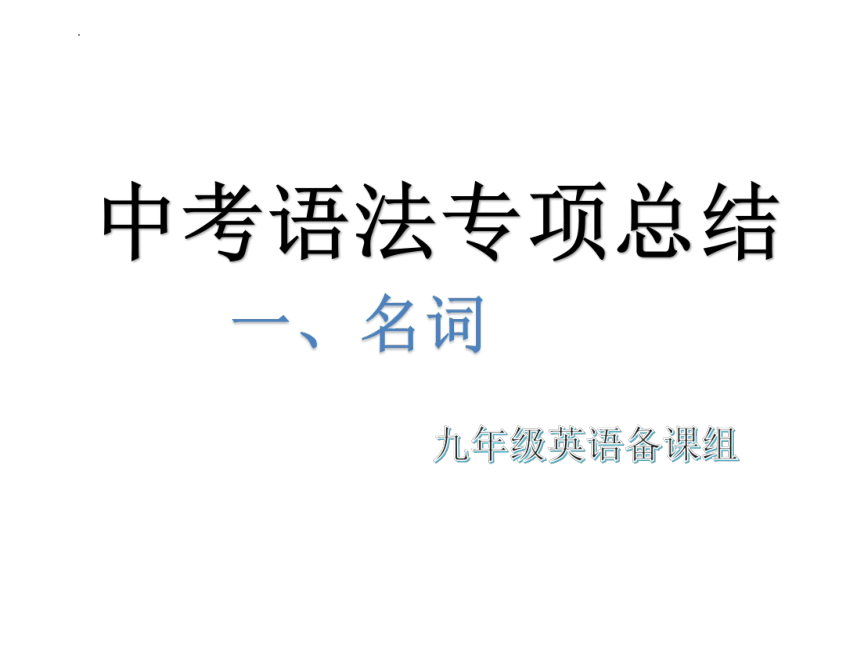
|
|
| 格式 | zip | ||
| 文件大小 | 118.0KB | ||
| 资源类型 | 教案 | ||
| 版本资源 | 人教新目标(Go for it)版 | ||
| 科目 | 英语 | ||
| 更新时间 | 2022-07-26 21:36:22 | ||
图片预览

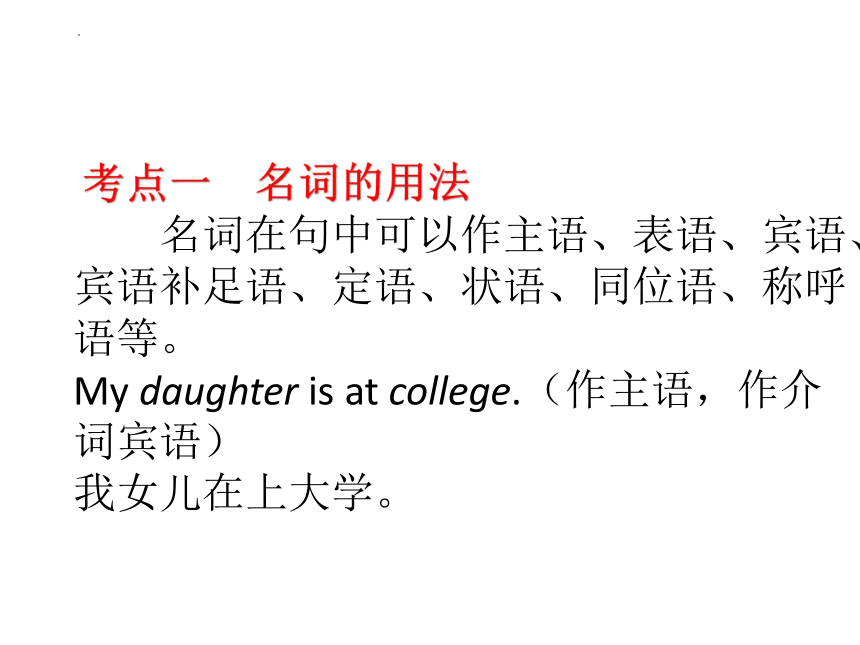
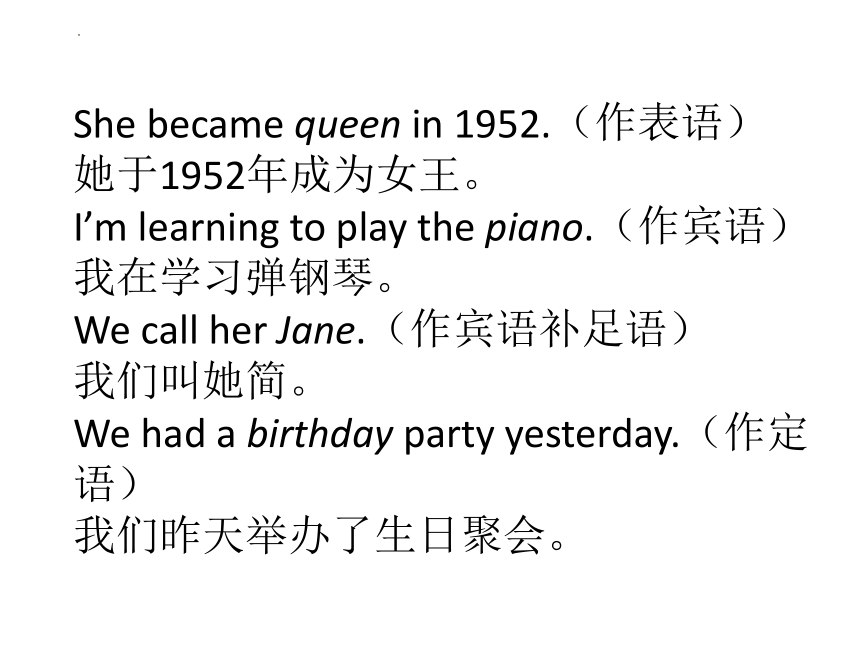
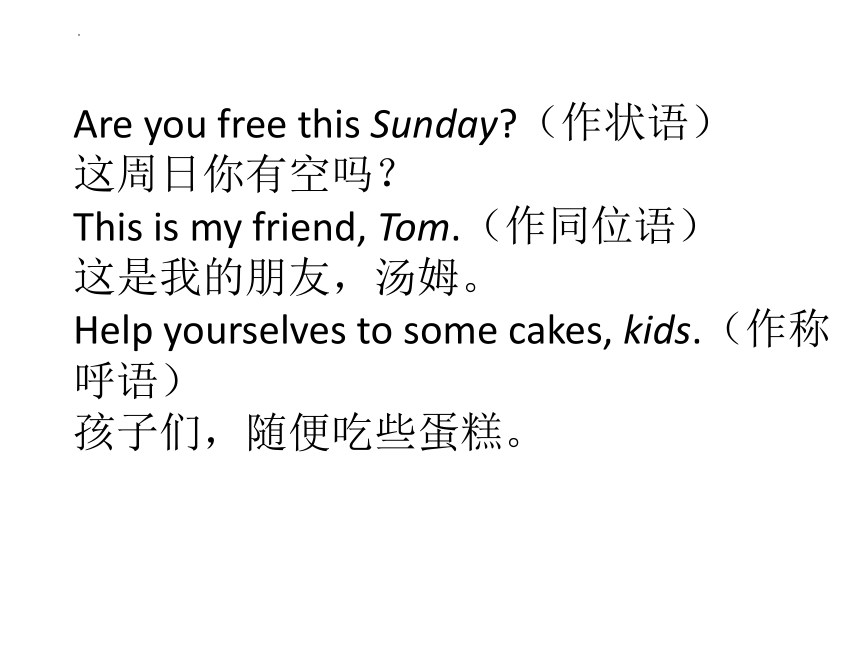
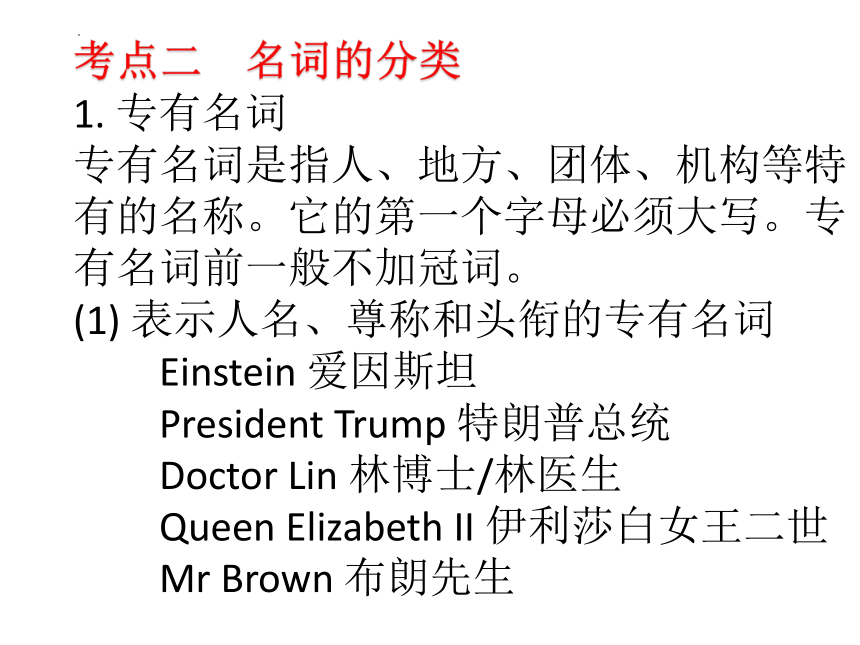
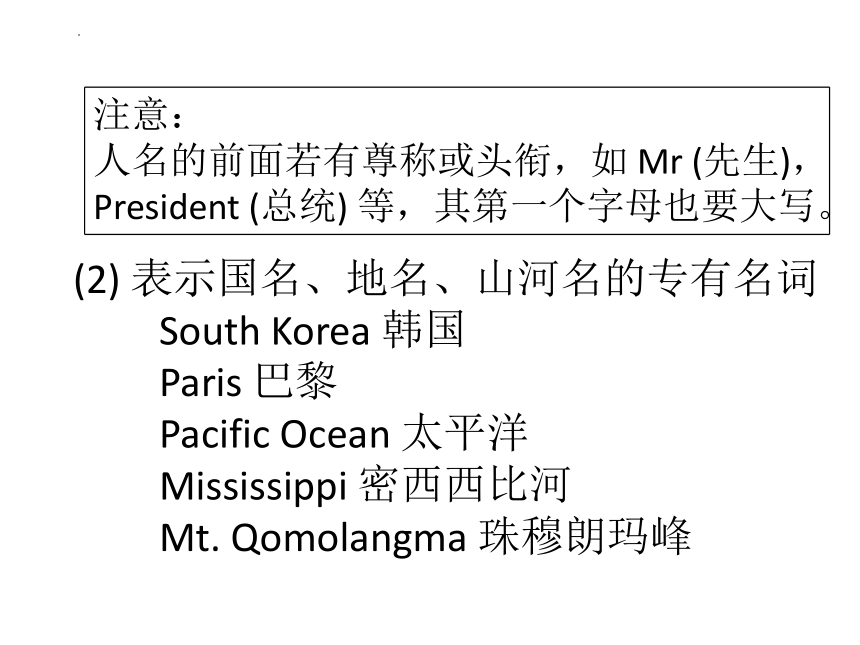

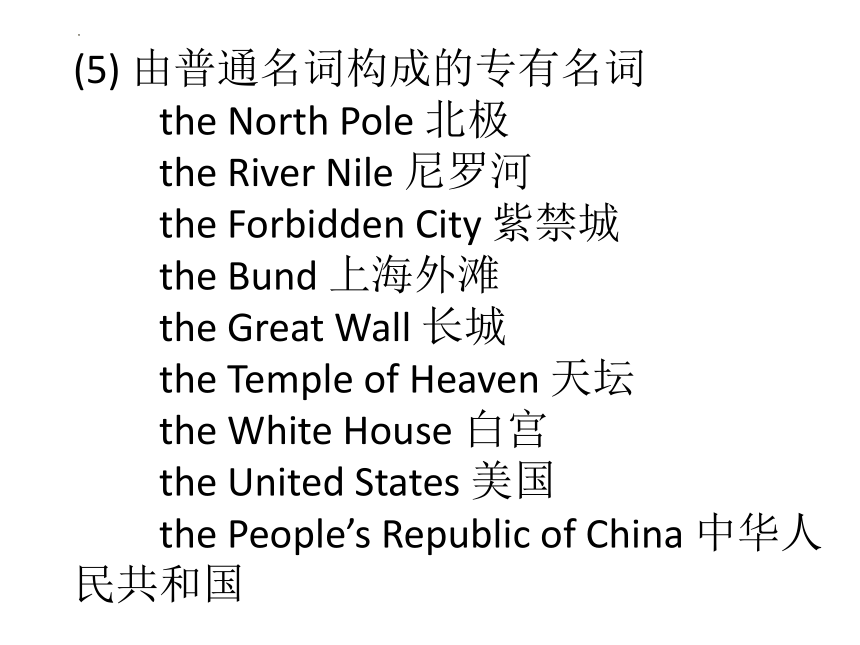
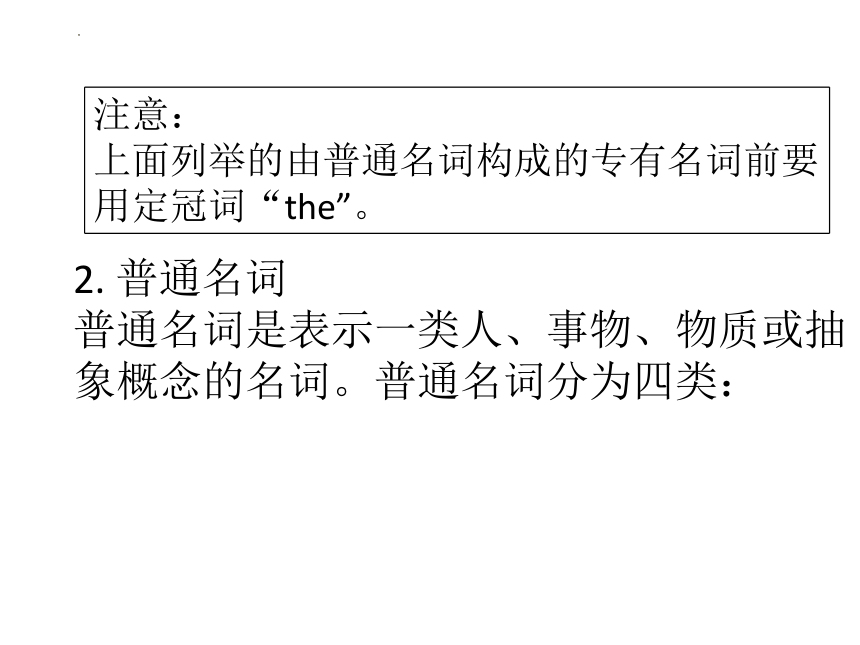

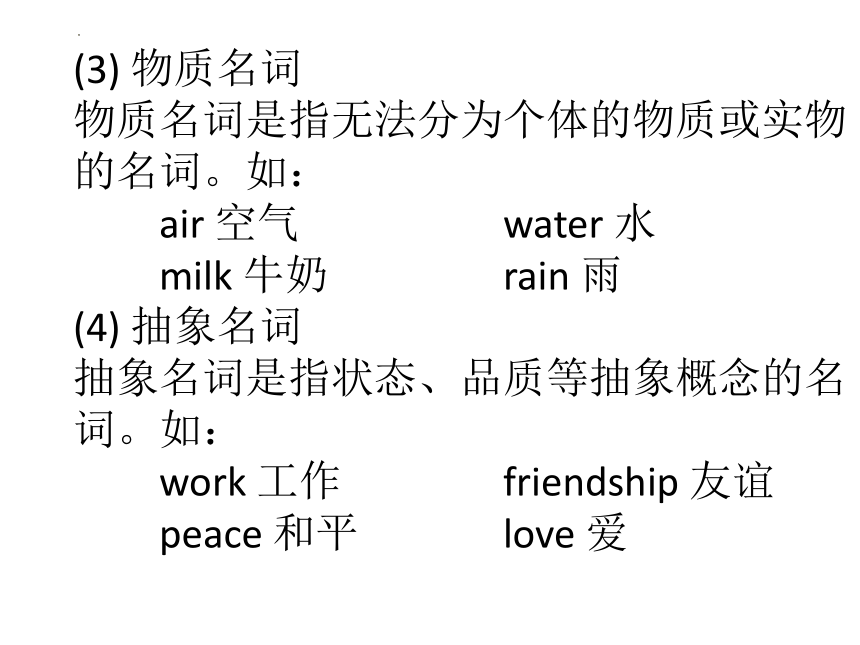
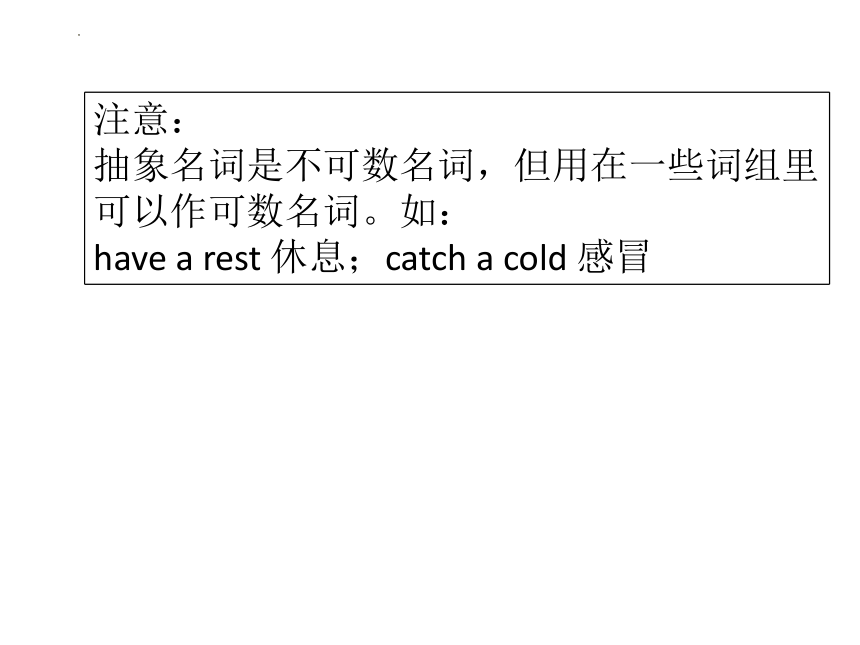
文档简介
(共42张PPT)
一、名词
中考语法专项总结
九年级英语备课组
考点一 名词的用法
名词在句中可以作主语、表语、宾语、宾语补足语、定语、状语、同位语、称呼语等。
My daughter is at college.(作主语,作介词宾语)
我女儿在上大学。
She became queen in 1952.(作表语)
她于1952年成为女王。
I’m learning to play the piano.(作宾语)
我在学习弹钢琴。
We call her Jane.(作宾语补足语)
我们叫她简。
We had a birthday party yesterday.(作定语)
我们昨天举办了生日聚会。
Are you free this Sunday (作状语)
这周日你有空吗?
This is my friend, Tom.(作同位语)
这是我的朋友,汤姆。
Help yourselves to some cakes, kids.(作称呼语)
孩子们,随便吃些蛋糕。
考点二 名词的分类
1. 专有名词
专有名词是指人、地方、团体、机构等特有的名称。它的第一个字母必须大写。专有名词前一般不加冠词。
(1) 表示人名、尊称和头衔的专有名词
Einstein 爱因斯坦
President Trump 特朗普总统
Doctor Lin 林博士/林医生
Queen Elizabeth II 伊利莎白女王二世
Mr Brown 布朗先生
(2) 表示国名、地名、山河名的专有名词
South Korea 韩国
Paris 巴黎
Pacific Ocean 太平洋
Mississippi 密西西比河
Mt. Qomolangma 珠穆朗玛峰
注意:
人名的前面若有尊称或头衔,如 Mr (先生),President (总统) 等,其第一个字母也要大写。
(3) 表示团体、机构和报刊的专有名词
Museum of Postal History 邮政博物馆
China Daily 《中国日报》
Sydney Opera House 悉尼歌剧院
Harvard University 哈佛大学
(4) 表示星期、月份和节日的专有名词
Monday 星期一
March 三月
National Day 国庆节
(5) 由普通名词构成的专有名词
the North Pole 北极
the River Nile 尼罗河
the Forbidden City 紫禁城
the Bund 上海外滩
the Great Wall 长城
the Temple of Heaven 天坛
the White House 白宫
the United States 美国
the People’s Republic of China 中华人民共和国
2. 普通名词
普通名词是表示一类人、事物、物质或抽象概念的名词。普通名词分为四类:
注意:
上面列举的由普通名词构成的专有名词前要用定冠词“the”。
(1) 个体名词
个体名词是指某类人或事物中的个体的名词。如:
teacher 教师 desk 书桌
box 盒子 city 城市
(2) 集体名词
集体名词是指由若干个体组成的集合体的名词。如:
family 家庭 police 警察
army 军队 government 政府
(3) 物质名词
物质名词是指无法分为个体的物质或实物的名词。如:
air 空气 water 水
milk 牛奶 rain 雨
(4) 抽象名词
抽象名词是指状态、品质等抽象概念的名词。如:
work 工作 friendship 友谊
peace 和平 love 爱
注意:
抽象名词是不可数名词,但用在一些词组里可以作可数名词。如:
have a rest 休息;catch a cold 感冒
习题
根据括号内的汉语提示完成句子。
1. When is ______________ (儿童节) in America
2. Would you like to go to ______________ (紫禁城) with me
3. I usually visit my grandparents on ______________ (星期天).
4. I ______________ (感冒). I’m not feeling well.
5. Do you like to read ______________ (《中国日报》)
Children’s Day
the Forbidden City
Sunday
have a cold
China Daily
考点三 可数名词的数
1. 规则变化
情况 构成方法 例词
一般情况 加 -s pen — pens; doctor — doctors; map — maps
以s, x, ch, sh 结尾 加 -es bus — buses; box — boxes; watch — watches; brush — brushes
以“辅音字母+ y”结尾 将y变为i 再加 -es factory — factories; family — families
以“元音字母+ y”结尾 只加 -s boy — boys; day — days
以o结尾 加 -es Negro — Negroes; hero — heroes;
potato — potatoes; tomato — tomatoes
巧记:黑人英雄喜欢吃土豆和西红柿。(两人两菜)
加 -s photo — photos; radio — radios; piano — pianos
以f或fe结尾 将f或fe变 为v再加 -es wife — wives; thief — thieves; shelf — shelves; knife — knives; wolf — wolves; half — halves; leaf — leaves; life — lives
巧记:妻见小偷架下藏,手拿小刀想杀狼,谁知落下半片叶,砸在头上一命亡。
加 -s roof — roofs
2. 不规则变化
(1) man — men; woman — women;
child — children; foot — feet; tooth — teeth;
goose — geese; mouse — mice
巧记:男女孩子脚步牙鹅加老鼠。
(2) 单复数相同:sheep — sheep; deer — deer; fish — fish
注意:
fish 强调鱼的条数的时候,单复数同形;强调鱼的种类的时候,复数形式要加 -es,即fishes。
(3) 某国人变复数的歌诀:中日不变英法变,其余 -s加后面。
Chinese — Chinese
Japanese — Japanese
Englishman — Englishmen
Frenchman — Frenchmen
American — Americans
3. 复合名词的数
(1) 一般情况下把后面一个名词变为复数,作定语的名词不变。
a girl student — five girl students;
an apple tree — ten apple trees
(2) 由man和woman构成的复合名词,变复数时要把名词和man/woman同时变为复数。
a man doctor — three men doctors;
a woman teacher — six women teachers
(3) sport作定语修饰其他名词时,无论中心词是单数还是复数,sport通常用复数形式。
a sports club; sports shoes
注意:时间名词作定语有两种形式
两天的假期:
a two-day holiday 或 two days’ holiday
十分钟的路程:
a ten-minute ride 或 ten minutes’ ride
4. 名词单数和复数的一些特殊情况
(1) 有些名词一般只用复数形式。
常见的有 trousers (裤子),shoes (鞋子),socks (短袜),jeans (牛仔裤),glasses (眼镜),clothes (衣服),stairs (楼梯),chopsticks (筷子)等。
(2) 有些以 -s 结尾的名词,它们不是名词的复数。
常见的有 maths (数学),physics (物理),politics (政治),means (方法)等。
(3) 集体名词既可以作单数,也可以作复数。
集体名词看作整体时,应为单数;看作整体中的各个成员时,应为复数。
All my family enjoy reading.
我全家都喜欢看书。
Almost every family in the country owns a television.
这个国家几乎家家都有一台电视机。
(4) 有些名词(如 people, police 等)指多数人,应看作复数。
How many people are there in the room
房间里有多少人?
The police are looking for the missing girl.
警察正在寻找那个丢失的女孩。
注意:
people 当“人们”讲时,本身是复数形式;当“民族”讲时,是单数形式,其复数形式要在末尾加 -s。如:a people; 56 peoples
习题
I. 汉译英。
1. 五个西红柿 five ____________
2. 两把刀 two ____________
3. 八只绵羊 eight ___________
4. 一些女作家 some ___________
5. 许多小孩 a lot of __________
6. 四名澳大利亚人 four ____________
tomatoes
knives
sheep
women writers
children
Australians
II. 用所给单词的适当形式填空。
1. The little baby has two ______________ (tooth) already.
2. There are three ______________ (bedroom) in this house.
3. His parents work in different ______________ (factory).
4. There are many ______________ (peach) in the basket.
teeth
bedrooms
factories
peaches
■ 考点四 不可数名词的数
1. 不可数名词没有复数形式,前面不能用不定冠词 a/an 修饰,但可用 much, a lot of / lots of, plenty of, some, little, a little 等修饰。作主语时谓语动词用单数形式。
There is some tea in the cup.
茶杯里有些茶。
2. 不可数名词还常用“数词/不定冠词 + 量词 + of + 不可数名词”来表示它的数量。如a piece of paper 一张纸,two cups of tea 两杯茶,a glass of water 一杯水,three bottles of water 三瓶水。作主语时,谓语动词的数取决于 of 前面的量词的数。
There are three glasses of water on the table.
桌子上有三杯水。
注意:
有些不可数名词表示具体事物时是可数名词,但表达的意思不同。
不可数名词 可数名词
chicken 鸡肉 a chicken 一只鸡
paper 纸 a paper 一张报纸
glass 玻璃 a glass 一个玻璃杯
room 空间 a room 一个房间
习题
I. 用所给单词的适当形式填空。
1. a little ____________ (work)
2. some ____________ (meat)
3. a lot of ____________ (time)
4. three ____________ (cup) of coffee
5. much ____________ (money)
6. two ____________ (pair) of trousers
work
meat
time
cups
money
pairs
II. 根据括号内的汉语提示完成句子。
1. There is some ____________ (面包) on the table.
2. I have some good ____________ (消息) for you.
3. I have a lot of ____________ (作业) to do today.
4. We can get a lot of ____________ (信息) from the Internet.
bread
news
homework
information
考点五 名词所有格
1. -’s所有格
情况 构成方法 例子
单数名词 加 -’s my friend’s uncle 我朋友的叔叔
以 s 结尾的复数名词 加 -’ Teachers’ Day 教师节
不以 s 结尾的复数名词 加 -’s Children’s Day 儿童节
表示两人共有 在最后一个名词后加 -’s Lucy and Lily’s mother 露西和莉莉的妈妈
表示各自所有 在每个名词后分别加 -’s Lucy’s and Lily’s rooms
露西的房间和莉莉的房间
注意:
(1) -’s 所有格通常用于表示人或其他有生命事物的名词后,但有时候也可以用于表示时间、距离、价格等的名词后,还可以用于表示国家、城市等地方的名词后。
It’s three minutes’ walk from my home to the school. 从我家到学校步行需三分钟。
Where is today’s newspaper 今天的报纸在哪里?
His car is at a stone’s throw. 他的车就在一箭之遥。
Do you know something about the city’s library 对于这个城市的图书馆你了解吗?
(2) -’s 表示店铺、学校、医院、住宅以及公共建筑时,-’s 所有格后面的名词通常省略。
at the teacher’s (office) 在老师的办公室里
at the doctor’s (office) 在诊所里
2.“of + 名词”所有格
主要用于表示无生命事物的所有关系。
the name of the film 电影的名字
the cover of the book 书的封面
注意:
(1) 有少数名词(如 key, answer, ticket 等),常用“to + 名词”构成所有格。
No one knows the answer to the question.
没有一个人知道这个问题的答案。
(2) 有时 -’s 所有格可以与“of + 名词”所有格互换。
The cat’s name (= The name of the cat) is Ben.
这只猫的名字叫本。
3. of + -’s 所有格
若表示所属的名词前已有冠词、数词、不定代词或指示代词等修饰,就应用“名词 + of + 名词性物主代词/-’s所有格”构成双重所有格形式。
a friend of hers 她的一个朋友
a friend of Mike’s 迈克的一个朋友
注意:
“of + -’s 所有格”和“of + 名词”所有格所表示的意义不同。
This is a photo of Jane’s. 这是简的一张照片。(此句是指照片归简所有,但至于照片里有什么,不清楚,可能是简本人,也有可能是其他。)
This is a photo of Jane. 这是一张简本人的照片。(此句是指照片上是简本人。)
习题
I. 汉译英。
1. 妇女节 ____________ Day
2. 汤姆的朋友 ____________ friend
3. 门的钥匙 the key ____________ the door
4. 房间的门 the door ____________ the house
5. 今天的报纸 ____________ newspaper
6. 十分钟的休息 ten ____________ rest
Women’s
Tom’s
to
of
today’s
minutes’
II. 用所给单词的适当形式填空。
1. The ____________ (city) scenery is very beautiful.
2. At last, he arrived at the ____________ (doctor) at twenty to five.
3. The boy in blue is a friend of ____________ (Lucy).
4. We should learn those ____________ (players) team spirit.
city’s
doctor’s
Lucy’s
players’
限时训练
一、名词
中考语法专项总结
九年级英语备课组
考点一 名词的用法
名词在句中可以作主语、表语、宾语、宾语补足语、定语、状语、同位语、称呼语等。
My daughter is at college.(作主语,作介词宾语)
我女儿在上大学。
She became queen in 1952.(作表语)
她于1952年成为女王。
I’m learning to play the piano.(作宾语)
我在学习弹钢琴。
We call her Jane.(作宾语补足语)
我们叫她简。
We had a birthday party yesterday.(作定语)
我们昨天举办了生日聚会。
Are you free this Sunday (作状语)
这周日你有空吗?
This is my friend, Tom.(作同位语)
这是我的朋友,汤姆。
Help yourselves to some cakes, kids.(作称呼语)
孩子们,随便吃些蛋糕。
考点二 名词的分类
1. 专有名词
专有名词是指人、地方、团体、机构等特有的名称。它的第一个字母必须大写。专有名词前一般不加冠词。
(1) 表示人名、尊称和头衔的专有名词
Einstein 爱因斯坦
President Trump 特朗普总统
Doctor Lin 林博士/林医生
Queen Elizabeth II 伊利莎白女王二世
Mr Brown 布朗先生
(2) 表示国名、地名、山河名的专有名词
South Korea 韩国
Paris 巴黎
Pacific Ocean 太平洋
Mississippi 密西西比河
Mt. Qomolangma 珠穆朗玛峰
注意:
人名的前面若有尊称或头衔,如 Mr (先生),President (总统) 等,其第一个字母也要大写。
(3) 表示团体、机构和报刊的专有名词
Museum of Postal History 邮政博物馆
China Daily 《中国日报》
Sydney Opera House 悉尼歌剧院
Harvard University 哈佛大学
(4) 表示星期、月份和节日的专有名词
Monday 星期一
March 三月
National Day 国庆节
(5) 由普通名词构成的专有名词
the North Pole 北极
the River Nile 尼罗河
the Forbidden City 紫禁城
the Bund 上海外滩
the Great Wall 长城
the Temple of Heaven 天坛
the White House 白宫
the United States 美国
the People’s Republic of China 中华人民共和国
2. 普通名词
普通名词是表示一类人、事物、物质或抽象概念的名词。普通名词分为四类:
注意:
上面列举的由普通名词构成的专有名词前要用定冠词“the”。
(1) 个体名词
个体名词是指某类人或事物中的个体的名词。如:
teacher 教师 desk 书桌
box 盒子 city 城市
(2) 集体名词
集体名词是指由若干个体组成的集合体的名词。如:
family 家庭 police 警察
army 军队 government 政府
(3) 物质名词
物质名词是指无法分为个体的物质或实物的名词。如:
air 空气 water 水
milk 牛奶 rain 雨
(4) 抽象名词
抽象名词是指状态、品质等抽象概念的名词。如:
work 工作 friendship 友谊
peace 和平 love 爱
注意:
抽象名词是不可数名词,但用在一些词组里可以作可数名词。如:
have a rest 休息;catch a cold 感冒
习题
根据括号内的汉语提示完成句子。
1. When is ______________ (儿童节) in America
2. Would you like to go to ______________ (紫禁城) with me
3. I usually visit my grandparents on ______________ (星期天).
4. I ______________ (感冒). I’m not feeling well.
5. Do you like to read ______________ (《中国日报》)
Children’s Day
the Forbidden City
Sunday
have a cold
China Daily
考点三 可数名词的数
1. 规则变化
情况 构成方法 例词
一般情况 加 -s pen — pens; doctor — doctors; map — maps
以s, x, ch, sh 结尾 加 -es bus — buses; box — boxes; watch — watches; brush — brushes
以“辅音字母+ y”结尾 将y变为i 再加 -es factory — factories; family — families
以“元音字母+ y”结尾 只加 -s boy — boys; day — days
以o结尾 加 -es Negro — Negroes; hero — heroes;
potato — potatoes; tomato — tomatoes
巧记:黑人英雄喜欢吃土豆和西红柿。(两人两菜)
加 -s photo — photos; radio — radios; piano — pianos
以f或fe结尾 将f或fe变 为v再加 -es wife — wives; thief — thieves; shelf — shelves; knife — knives; wolf — wolves; half — halves; leaf — leaves; life — lives
巧记:妻见小偷架下藏,手拿小刀想杀狼,谁知落下半片叶,砸在头上一命亡。
加 -s roof — roofs
2. 不规则变化
(1) man — men; woman — women;
child — children; foot — feet; tooth — teeth;
goose — geese; mouse — mice
巧记:男女孩子脚步牙鹅加老鼠。
(2) 单复数相同:sheep — sheep; deer — deer; fish — fish
注意:
fish 强调鱼的条数的时候,单复数同形;强调鱼的种类的时候,复数形式要加 -es,即fishes。
(3) 某国人变复数的歌诀:中日不变英法变,其余 -s加后面。
Chinese — Chinese
Japanese — Japanese
Englishman — Englishmen
Frenchman — Frenchmen
American — Americans
3. 复合名词的数
(1) 一般情况下把后面一个名词变为复数,作定语的名词不变。
a girl student — five girl students;
an apple tree — ten apple trees
(2) 由man和woman构成的复合名词,变复数时要把名词和man/woman同时变为复数。
a man doctor — three men doctors;
a woman teacher — six women teachers
(3) sport作定语修饰其他名词时,无论中心词是单数还是复数,sport通常用复数形式。
a sports club; sports shoes
注意:时间名词作定语有两种形式
两天的假期:
a two-day holiday 或 two days’ holiday
十分钟的路程:
a ten-minute ride 或 ten minutes’ ride
4. 名词单数和复数的一些特殊情况
(1) 有些名词一般只用复数形式。
常见的有 trousers (裤子),shoes (鞋子),socks (短袜),jeans (牛仔裤),glasses (眼镜),clothes (衣服),stairs (楼梯),chopsticks (筷子)等。
(2) 有些以 -s 结尾的名词,它们不是名词的复数。
常见的有 maths (数学),physics (物理),politics (政治),means (方法)等。
(3) 集体名词既可以作单数,也可以作复数。
集体名词看作整体时,应为单数;看作整体中的各个成员时,应为复数。
All my family enjoy reading.
我全家都喜欢看书。
Almost every family in the country owns a television.
这个国家几乎家家都有一台电视机。
(4) 有些名词(如 people, police 等)指多数人,应看作复数。
How many people are there in the room
房间里有多少人?
The police are looking for the missing girl.
警察正在寻找那个丢失的女孩。
注意:
people 当“人们”讲时,本身是复数形式;当“民族”讲时,是单数形式,其复数形式要在末尾加 -s。如:a people; 56 peoples
习题
I. 汉译英。
1. 五个西红柿 five ____________
2. 两把刀 two ____________
3. 八只绵羊 eight ___________
4. 一些女作家 some ___________
5. 许多小孩 a lot of __________
6. 四名澳大利亚人 four ____________
tomatoes
knives
sheep
women writers
children
Australians
II. 用所给单词的适当形式填空。
1. The little baby has two ______________ (tooth) already.
2. There are three ______________ (bedroom) in this house.
3. His parents work in different ______________ (factory).
4. There are many ______________ (peach) in the basket.
teeth
bedrooms
factories
peaches
■ 考点四 不可数名词的数
1. 不可数名词没有复数形式,前面不能用不定冠词 a/an 修饰,但可用 much, a lot of / lots of, plenty of, some, little, a little 等修饰。作主语时谓语动词用单数形式。
There is some tea in the cup.
茶杯里有些茶。
2. 不可数名词还常用“数词/不定冠词 + 量词 + of + 不可数名词”来表示它的数量。如a piece of paper 一张纸,two cups of tea 两杯茶,a glass of water 一杯水,three bottles of water 三瓶水。作主语时,谓语动词的数取决于 of 前面的量词的数。
There are three glasses of water on the table.
桌子上有三杯水。
注意:
有些不可数名词表示具体事物时是可数名词,但表达的意思不同。
不可数名词 可数名词
chicken 鸡肉 a chicken 一只鸡
paper 纸 a paper 一张报纸
glass 玻璃 a glass 一个玻璃杯
room 空间 a room 一个房间
习题
I. 用所给单词的适当形式填空。
1. a little ____________ (work)
2. some ____________ (meat)
3. a lot of ____________ (time)
4. three ____________ (cup) of coffee
5. much ____________ (money)
6. two ____________ (pair) of trousers
work
meat
time
cups
money
pairs
II. 根据括号内的汉语提示完成句子。
1. There is some ____________ (面包) on the table.
2. I have some good ____________ (消息) for you.
3. I have a lot of ____________ (作业) to do today.
4. We can get a lot of ____________ (信息) from the Internet.
bread
news
homework
information
考点五 名词所有格
1. -’s所有格
情况 构成方法 例子
单数名词 加 -’s my friend’s uncle 我朋友的叔叔
以 s 结尾的复数名词 加 -’ Teachers’ Day 教师节
不以 s 结尾的复数名词 加 -’s Children’s Day 儿童节
表示两人共有 在最后一个名词后加 -’s Lucy and Lily’s mother 露西和莉莉的妈妈
表示各自所有 在每个名词后分别加 -’s Lucy’s and Lily’s rooms
露西的房间和莉莉的房间
注意:
(1) -’s 所有格通常用于表示人或其他有生命事物的名词后,但有时候也可以用于表示时间、距离、价格等的名词后,还可以用于表示国家、城市等地方的名词后。
It’s three minutes’ walk from my home to the school. 从我家到学校步行需三分钟。
Where is today’s newspaper 今天的报纸在哪里?
His car is at a stone’s throw. 他的车就在一箭之遥。
Do you know something about the city’s library 对于这个城市的图书馆你了解吗?
(2) -’s 表示店铺、学校、医院、住宅以及公共建筑时,-’s 所有格后面的名词通常省略。
at the teacher’s (office) 在老师的办公室里
at the doctor’s (office) 在诊所里
2.“of + 名词”所有格
主要用于表示无生命事物的所有关系。
the name of the film 电影的名字
the cover of the book 书的封面
注意:
(1) 有少数名词(如 key, answer, ticket 等),常用“to + 名词”构成所有格。
No one knows the answer to the question.
没有一个人知道这个问题的答案。
(2) 有时 -’s 所有格可以与“of + 名词”所有格互换。
The cat’s name (= The name of the cat) is Ben.
这只猫的名字叫本。
3. of + -’s 所有格
若表示所属的名词前已有冠词、数词、不定代词或指示代词等修饰,就应用“名词 + of + 名词性物主代词/-’s所有格”构成双重所有格形式。
a friend of hers 她的一个朋友
a friend of Mike’s 迈克的一个朋友
注意:
“of + -’s 所有格”和“of + 名词”所有格所表示的意义不同。
This is a photo of Jane’s. 这是简的一张照片。(此句是指照片归简所有,但至于照片里有什么,不清楚,可能是简本人,也有可能是其他。)
This is a photo of Jane. 这是一张简本人的照片。(此句是指照片上是简本人。)
习题
I. 汉译英。
1. 妇女节 ____________ Day
2. 汤姆的朋友 ____________ friend
3. 门的钥匙 the key ____________ the door
4. 房间的门 the door ____________ the house
5. 今天的报纸 ____________ newspaper
6. 十分钟的休息 ten ____________ rest
Women’s
Tom’s
to
of
today’s
minutes’
II. 用所给单词的适当形式填空。
1. The ____________ (city) scenery is very beautiful.
2. At last, he arrived at the ____________ (doctor) at twenty to five.
3. The boy in blue is a friend of ____________ (Lucy).
4. We should learn those ____________ (players) team spirit.
city’s
doctor’s
Lucy’s
players’
限时训练
同课章节目录
- 词法
- 名词
- 动词和动词短语
- 动词语态
- 动词时态
- 助动词和情态动词
- 非谓语动词
- 冠词
- 代词
- 数词和量词
- 形容词副词及其比较等级
- 介词和介词短语
- 连词和感叹词
- 构词法
- 相似、相近词比较
- 句法
- 陈述句
- 一般疑问句和否定疑问句
- 特殊疑问句及选择疑问句
- 反意疑问句
- 存在句(There be句型)
- 宾语从句
- 定语从句
- 状语从句
- 主谓一致问题
- 简单句
- 并列句
- 复合句
- 主谓一致
- 主、表语从句
- 名词性从句
- 直接引语和间接引语
- 虚拟语气
- 感叹句
- 强调句
- 倒装句
- 祈使句
- 句子的成分
- 句子的分类
- 题型专区
- 单项选择部分
- 易错题
- 完形填空
- 阅读理解
- 词汇练习
- 听说训练
- 句型转换
- 补全对话
- 短文改错
- 翻译
- 书面表达
- 任务型阅读
- 语法填空
- 其他资料
